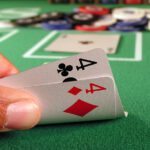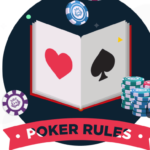Here is a topic that we have been debating about in another thread: Pot Equity Edge….and what the hell do you do with it?
When we get to debating topics, it does a couple of things for me, personally. First, it makes me choose a side and "fight." Second, it makes me go to my books and look up what i need to know for the side I chose. All this really does is help us all grow by teaching or revisiting concepts. And, for that reason alone, I love the debates we can get into here.
Hmmmm, Pot Equity Edge, where to begin. Let’s start here….with a definition. PEE (as I will refer to it from here on out) is defined as: You have a PEE if you expect to win more often than your average opponent. If you have four opponents, the "average" player can expect to win 20% of the time (1 in 5). If you expect to win 30% of the time, you have a PEE.
OK, so now what the hell do we do with it?
Usually, we will be raising instead of calling. Folding is going to be a pretty terrible option, so our only debate will be to call or raise.
Example
You are in a very loose and aggressive game. Your villains are prone to raise and reraise flops with draws and pairs, as well as, bigger hands like sets and 2pr. You are on the button with Ah8h. The UTG player raises, four people cold-call, you call, and so do both blinds. (pot is 16sb) The flop comes Th9h2s, giving you the nut flush draw and an overcard. The SB bets, BB calls, and the preflop raiser raises. Two more players cold-call, and two others fold. The pot is now 24 sb’s, and you are faced with 2 sb’s to call. What do you do?
You freaking RERAISE! You have a big draw to the nuts. By the river, you will make the nut flush about 35% of the time, right? And, sometimes, you will win just by spiking your ace. With five more opponents, you will win FAR more often than your "average opponents." 6 players and you "should" win 1/6 of the time, or 17%. Since you have the nut flush draw and an overcard, you will win more than 35% of the time. Since you have such a huge PEE, your reraise is for value!!!
Also, since you have position, that reraise may allow you to take a free card on the turn, if you choose. But, don’t automatically take the free card. WHY?
Let’s look just a touch farther to see how your PEE will affect the turn.
In such a large pot, at such a loose table, it is unlikely you will fold many, if any, of the remaining players off. And, you don’t want them to fold anyway. This is building a pot properly for a big payout with a big draw. Let’s assume no one folds. Simply stated, you now have 5 villains in the pot for the turn. Even if the turn bricks, you will still have a 1 in 4 shot to win with your flush. That is 25%! With 5 villains, you "should" only have a 20% chance to win. Again, you have a PEE. Granted, it is not as large as it was, so we are not going to go absolutely bonkers on a turn card. But, if it checks to us, it is +EV to put a bet into the pot.
Does this make sense?
Now, when would you NOT raise the flop on a huge draw where you likely have your PEE? When you would be potentially knocking others out of the hand, thereby destroying your PEE for the turn.
Another Example
You are playing at a tighter table this time. You have Ah8h and you call along after 3 limpers have entered the pot. (We can argue a raise here, too, by the way.) However, let’s assume that the BB checks, too. We have 4 villains in this pot and flop the nut flush draw again on a Kh7h3d board (pot is 5.5 sb). BB checks, 2 limpers check, and the 3rd limper (the guy on your right) fires a bet into the pot. OK, sure, we have a PEE here (35% chance when we have an average shot of 1 in 5 (20%)), but our raise, although for value, would be forcing the others to call 2 sb’s cold in a smallish pot. (5.5 sb to start and limper #3 puts in a sb. if we fire a raise at the pot, we make the pot 8.5 sb, but the others have to call 2 sb’s into it. That makes things 8.5/2 or 4.25:1 to call.) The 4.25:1 odds, the raise from us, AND the fact that our limpers already checked the flop off will definitely fold off players most of the time. If it cuts our field down from 5 total players to 2-3, we have lost a lot of our PEE. If the turn doesn’t give us our flush, we will drop to a 25% chance to hit it on the river. With 3 players in the pot, we will have only an average chance of 33% to win the pot. Since 25% is less than 33%, we have completely lost any PEE we had, and, therefore, have to play by only pot odds from here on out. Therefore, even though we had the same basic PEE on the flop, our "relative position" was poor. So much so, that we did more damage than good by raising for value.
I hope this makes some sense.
In conclusion, we should remember some key points to PEE.
– If we have a PEE, our raise is for VALUE despite the fact we may not have the best hand at the moment.
– When we confirm we have a PEE, we need to consider heavily our "relative position" when the flop betting starts. Will we draw others in to a bigger pot, or will we shut them out by forcing them to call 2 bets, or more, cold?
– Do we have the chance to take a free card on the turn with our position?
These clues will help you to build bigger pots with your stronger draws. Hopefully, this will bump your winrates from here on out.
Credit for the examples, and concept, should also go to SSHE by Sklansky, Malmuth, and Miller.
Submit your review | |










